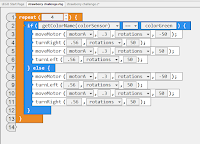Or "Capturing Footage of a Wild Animal"
The first semester for our school has come to end. During the last several weeks, the students worked on their final project which was to be performed at the last middle school assembly of the semester, literally just minutes before being dismissed for winter break.
The students and I met in the theater in the morning to do several last run throughs. It worked fairly well, but probably would not work perfectly. Robots sometimes have minds of their owns, it seems. The robot starting positions were marked and the blue, green, red and white tape was laid out on the stage. The robots were supposed to move forward in formation to the green line and stop and wave their flags in sequence. Then the center robot would move out of the way for the torch robot to move forward across the stage, stop at the red line and do a ninety degree turn to face the audience. Once the center robot moved back into position, all the robots with their flags up would move forward to the blue line, stop, back up and turn to face the audience. They would then follow the white line staying a set distance behind the robot in front using their ultrasonic sensor. Once the lead robot stopped at the barrier, all the robots were supposed to stop and wave their flags once or until the barrier was removed.
The following video is of the assembly and shows robots not cooperating.
Post assembly, the students bolted for winter break leaving me unsatisfied with the performance. Therefore, I came into school one morning during break to debug the robots and record what should have happened.
With my heart pounding, I coordinated the camera, the music and the robots singlehandedly and managed to get the following on the first take. It wasn't perfect as you will see. "That'll do," I said to myself. When I turned off the camera, I literally felt like I had captured footage of a wild animal never to be seen again. Enjoy.
As always, thank you for reading and viewing.
Happy New Year everyone.




